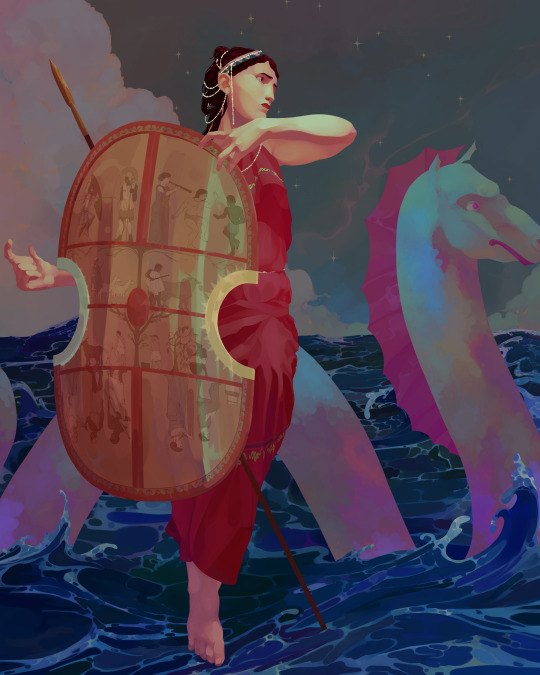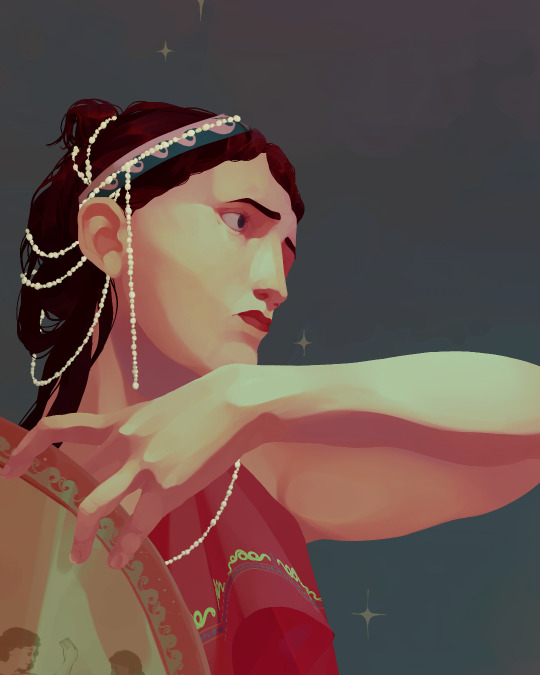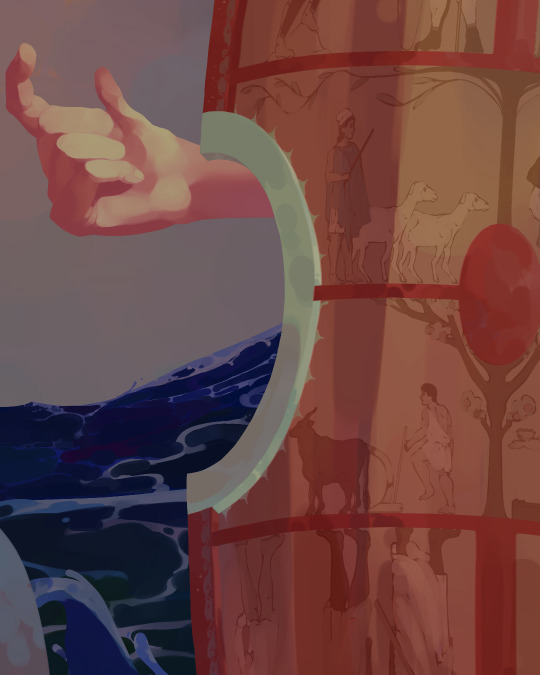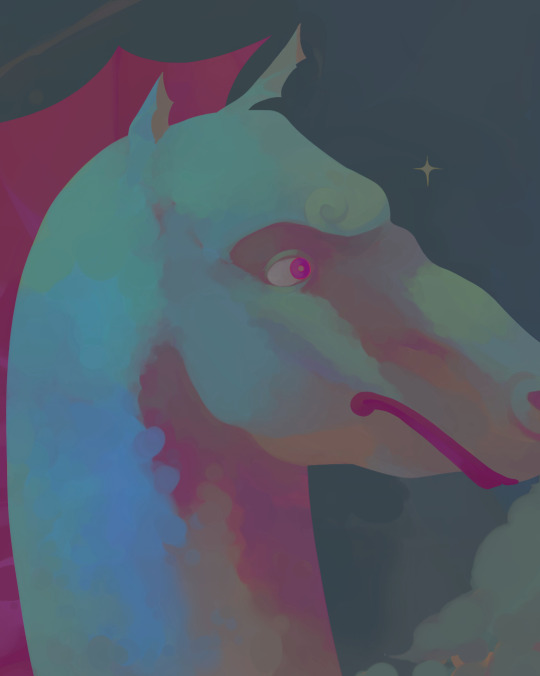#There is this strange (culturally catholic I think) thought to draw parallels between her and the virgin Mary
Explore tagged Tumblr posts
Text

Thetis with the arms of Achilles
I saw several mosaics depicting this motive and decided to try my hand at it as well.
Also, I just find Thetis to be quite interesting as a character. There’s gotta be something fundamentally Tragic about raising a child, knowing that he will most likely die very young.
*
*
*
(Close-Ups)



#There is this strange (culturally catholic I think) thought to draw parallels between her and the virgin Mary#but I don’t know how to properly articulate or build on this idea…#Also#sidenote#but I’m cursing Homer for having the ekphrases in the iliad be more living scene than static image#thus making it very difficult to draw them#art#digital art#digital painting#greek mythology#greek mythology art#tagamemnon#the iliad#Thetis
1K notes
·
View notes
Photo

Week 5 - Byzantium, Islam, and the Early Middle Ages
The Early Middle Ages begins with an ending. That is, the end of the Roman Empire. In 476 AD, the Roman Empire falls to the invasion of a barbarian army. While the Western part of the Roman Empire was finished, the eastern part lived on until around 1400 AD and is known as the Byzantine Empire (for it’s capitol of Constantinople, which was originally named Byzantium). The Byzantine Empire’s most notable emperor is that of Justinian and his wife Theodora. Under them the empire remained strong. Justinian codified the existing Roman law into the Corpus Juris Civilis, which remains a basis for much of Europe’s law to this day. He also built the massive and beautiful Hagia Sophia (pictured above), which still stands and exists as a museum. Justinian attempted to reconquer the Roman Empire with moderate success, but was stopped by a plague that took nearly 25 million lives. After this, he left the West to barbarian tribes that began cultivating their own languages and rich cultures. However, the Roman Catholic church and the seat of the Pope remained strong and most of the West soon converted to Christianity. Latin, however, faded from use and was replaced with local dialects - the beginnings of English, German, French, Spanish, and so on. However, much of the Latin documents that we have today are present due to the monasteries that made a point of preserving and copying them.
Meanwhile, in 622, the Prophet Muhammad made his Hijrah from Mecca to Medina and so began the Islamic Era. His new religion, Islam, traveled all around the Mediterranean and was only stopped spreading by the Byzantine Empire and the Franks.
So what did I take from this section of the class?
Empress Theodora is endlessly impressive, and the ultimate rags-to-riches story. I recently watched The Ascent of Woman with Amanda Foreman, and Theodora was a featured character so I was instantly hooked. As a feminist, her rise from dancing girl to Empress of the Byzantine Empire was absolutely wonderful.
The Celts! Oh, the Celts. I loved this section for so many reasons. As far as spirituality goes, I think that the best way to describe myself would be as ‘pagan’, and I take much of my spiritual inspiration from many different Celtic and Norse influences so it’s always wonderful to see a focus on these different parts of something that is deeply spiritual and personal to me taught in an academic setting. I also really thought that the parallels drawn between the Celtic culture and that of Native Americans was interesting, and it’s fascinating how many of these cultures also seem to have a more open role for women in them.
The next thing that I found fascinating about the section on the Celts actually has to do with my own family history. Recently, I took a DNA test that told me that I was a majority Irish (I am an American, but I am genetically more Irish than many people currently living in Ireland, interestingly enough) and a smaller mix of English, Scottish, French, etc. What I found curious was that nearly 12% of my DNA is linked to the Iberian Peninsula. I always thought that this was so strange, as none of my family was Spanish that I knew of. However, when Dr. Frederick explained that the Celts were descended from native Iberians, it all clicked and it’s absolutely fascinating being able to draw a map of how my ancestors traveled through the world to where I am now.
banner made by myself.
photo credit.
0 notes
Text
Hyperallergic: Making Art from a City’s Isolation
Detail of Ron Tran’s “Ashes Under the Hill/Let Our Hands Grow to Hold What We Love” (2017) (photo by the author for Hyperallergic)
WINNIPEG, Manitoba — On a Thursday night in August, a crowd of people inside an empty gallery in Plug In Institute of Contemporary Art peered through the windows at a red, eight-foot Om symbol that was being secured to a flatbed truck and readied to traverse the city. Titled “Nobody pray for me, the road to hell is paved with good intentions (Mapping Identity: The Challenges of Immigrant Culture),” by Winnipeg-based artist Divya Mehra, the Om sign is one of several sculptures and performances (all from 2017) located around Winnipeg for Plug In’s summer exhibition, Stages: Drawing the Curtain; it touches on many of the themes that run through the show: absurdity; confrontation; identity politics; and the denaturalization of public space.
Stages, a public art project featuring nine artists from Canada, Europe and Central America, is the concept of its curator Jenifer Papararo, who is also Executive Director of Plug In. Formerly a curator at the Contemporary Art Gallery in Vancouver, Papararo has spent the past three years at Plug In cultivating a rigorous exhibition program and bringing both the museum and the city out from under the shadow of Winnipeg’s most famous art-exports, filmmaker Guy Maddin and the ’90s art collective, the Royal Art Lodge. With Stages she re-imagines the city as “a performative site of fluctuating and active meaning” and “a character in each of the artworks.”
Once a leading railway hub for North American trade — called the “Chicago of the North” because of its parallel architecture and development at the turn of the 20th century — Winnipeg began an economic decline with the opening of the Panama Canal in 1914. The economic downturn continued throughout the 20th century, with the advent of suburban indoor malls drawing business away from the downtown area. The combination of geographic isolation and economic decline resulted in a landscape of abandoned and renegade spaces, many of which host the works in Stages.
Detail of Toril Johannessen’s “The Invention and Conclusion of the Eye” (2017) (photo by the author for Hyperallergic)
One of them is the Hudson’s Bay Company building, a former luxury department store on Winnipeg’s downtown thoroughfare Portage Avenue, now partially vacant and serving as the site for two audio pieces, The Invention and Conclusion of the Eye by Norwegian artist Toril Johannessen and Potato Gardens Band by Vancouver-based Krista Belle Stewart.
Johannessen’s 40-minute audio drama (also broadcast on local radio each Sunday of the show’s duration) narrates the eye’s evolution in nature through an extended meditation by a software designer called Mx. The paradox of the piece — an audio recording about sight — draws attention to the act of perception and the immediate environment: scientific eye diagrams folded into origami fortune tellers are piled inconspicuously on a table; light changes from warm to cool almost imperceptibly throughout the play; daisies mentioned in passing are arranged in a vase; signs for prosthetic limbs hang nearby. Although minor bits of scenery were added or arranged by the artist, the vast space on the building’s fourth floor remained largely untouched, with Kafka-esque details such as a lone desk and chair in a back room emerging as the absurd in reality.
Krista Belle Stewart’s installation, Potato Gardens Band, which features a digitized wax-cylinder recording of music by her great-grandmother, Terese Kaimetko, recorded by anthropologist James Alexander Teit, might have been better served in a gallery or museum setting. A member of the Upper Nicola Band of the Okanagan Nation, Stewart investigates narrative and interpretation, particularly in relation to indigenous histories. Her installation of spotlights and smoke near a row of mirrored columns creates a sense of being transported in time, which suits the recording’s ghostly quality, but the dimly lit basement feels too haunted on its own. Although the manipulated visual effects, in combination with the gloom of the basement, detract from an otherwise entrancing recording, the subterranean space evokes the economic and social marginalization of — and the long history of brutality and violence against — the city’s large indigenous population.
Issues of identity, otherness and discrimination are equally complicated in Mehra’s “Nobody pray for me” and in works by Toronto-based artist Abbas Akhavan.
Mehra – the only Winnipeg native in Stages who lives in the city and a first-generation Indian Canadian — uses humor less to diffuse conflict than to ambush the viewer. In a 2013 Hyperallergic interview, she explains, “I’m hoping [viewers] see the work and think: ‘Hahaha that’s so funny!’ and then something like the thought ‘OMFG WHAT AM I LAUGHING AT’ happens.”
Divya Mehra, “Nobody pray for me, the road to hell is paved with good intentions (Mapping Identity: The Challenges of Immigrant Culture)” (2017) (photo by Divya Mehra)
With “Nobody pray for me,” the Om symbol (which accompanies objects of worship in Hinduism, but is not a primary object, like the Christian cross) morphs into a seductive glowing, cherry-red logo that evokes the symbol’s appropriation by an affluent (and largely white) wellness culture in North America and its deviation from religious to “lifestyle” associations; as it is driven around the city on the flatbed truck, it seems as if it’s on an endless search for a destination somewhere between nightclub and yoga studio. The route, which was the one that Mehra took as a child on her way to Catholic school, travels north to a largely South Asian community and south to her childhood home in a predominantly white suburb, mapping a topography of otherness — her own as an artist, woman, and person of color, and that of the city’s non-white population.
For Variations on a Monument, Abbas Akhavan organized a series of performances showcasing Winnipeg’s drag scene. Set on a fountain plinth at a public park overlooking the Assiniboine River, the performances merge queer and drag subcultures with an Iranian tradition of transforming fountains into makeshift stages. The intersection of “public” and “private” suggested by the relocation of club acts to an open park is echoed in the scheduling of the performances at sunset. The plinth, on which a monument originally stood, anoints the drag queen as a living monument to marginalization, the return of normative society’s repressed.
Abbas Akhavan, “Variations on a Monument” (2017) (photo by Suzie Smith)
With “Ashes Under the Hill/Let Our Hands Grow to Hold What We Love,” Vancouver-based artist Ron Tran addresses the return of a different kind of repression. Tran, whose practice addresses issues of consumerism and waste, installed collaged cutouts of Canadian products from the first half of the 20th century at The Forks, a riverside park. The piece was inspired by Westview Park, a public space in Winnipeg’s suburbs converted from a landfill in 1960 and still unofficially called “Garbage Hill.” The artist chose The Forks, a bustling tourist destination, based on its high volume of consumption and waste. While the level of activity obstructed the cutouts at times, which emerge from manicured bushes, the area — lined with restaurants, shops, and a large marketplace — contributes to Tran’s commentary; it bespeaks the irony of “resolving” a landfill problem, as the case with “Garbage Hill,” with businesses that beget more waste.
Erica Eyres, “Head” (2017) (photo by Divya Mehra)
Erica Eyres, whose drawings, videos, and sculptures traffic in absurdity, hyperbolizes the strange and singular with “Head,” a giant, clown-like inflatable head affixed to the roof of a shuttered Mini Mart slated for demolition. An amateurish mural depicting bike riders and a woman in funereal dress adorns the side of the building. Eyres, a Winnipeg native based in Glasgow, Scotland, relates “Head” to the inflatable figures used to advertise store openings, but, she told me, her grinning, greenish-gray “decapitated head [instead] commemorates the closure of a business and the death of a building.” Too awkward to be frightening, the piece invokes an uncanny sense of unease, all the weirder in the way it invades the tranquility of a restaurant patio next door.
For his part, Costa Rican artist Federico Herrero produces a dizzying redefinition of space by painting the floor of a gray underground tunnel connecting municipal buildings in dazzling yellows, blues, and greens layered with abstract, organic shapes. Herrero’s “Landscape” at once enlivens the tunnel with colors characteristic of Central and South American art and architecture (underscoring, by extension, the differences between Central and South American culture and that of North America) and stimulates diverse reactions among visitors (a corridor in bright yellow,was one such trigger — it might invigorate some visitors, but it felt disorienting and claustrophobic to me).
Federico Herrero, “Landscape” (2017) (photo by the author for Hyperallergic)
Among the works that I caught during my tour of Stages, Kara Hamilton’s “Curtain Wall” and Pablo Bronstein’s Peony Unfurling at Various Speeds in Shopping Mall engage the most directly with the notion of the stage.
“Curtain Wall” is a large rectangular “wall” carved from local Tyndall limestone, located in a park next to a walking trail alongside the Assiniboine River. Hamilton, in her artist’s statement for Stages, cites Jennifer Krasinski’s one-line play Curtain from Prop Tragedies (2010) as a partial inspiration for the piece: “When in doubt, she wrote, blame the window for the view.” The settling evokes an abandoned amphitheater; two large, close-set, eye-shaped holes or “windows” in the wall create a dynamic in which passers-by look both at and through the piece, while the wall simultaneously blocks a full view of the river and with its eyeholes, looks back at the viewer.
Kara Hamilton, “Curtain Wall” (2017) (photo by the author for Hyperallergic)
A kind of counterpart to The Invention and Conclusion of the Eye, Toril Johannessen’s audio drama of optics, the streamlined simplicity of the piece belies its complex dialogue with seeing, being seen, and what is unseen — Tyndall stone constitutes most of Winnipeg’s municipal buildings — and reifying the role of the wall as the very fabric of separation and, increasingly, discrimination.
Peony Unfurling at Various Speeds in Shopping Mall, a dance performance conceived by Pablo Bronstein and co-choreographed by the artist and dancer/choreographer Rosalie Wahlfrid, took place at the Fort Garry Place Mall. Constructed in the 1980s, at the height of postmodern pastiche architecture, it’s the kind of space that feels deserted even when it is occupied. The mixing and faking of architectural and decorative styles — chandeliers, trompe l’oeil marble columns, a gilded mezzanine, and faux Rococo and Baroque paintings — reflects the pastiche in Bronstein’s drawings and paintings of real and imagined architecture.
The performance, a synthesis of ballet and modern dance, featuring Wahlfrid and seven local dancers, might have been campy in the hands of another artist, but Bronstein and Wahlfrid’s sincerity was evident in the technique and grace of the work, complementing the idiosyncratic sincerity of the building’s design.
Pablo Bronstein (co-choreographed by Rosalie Wahlfrid), “Peony Unfurling at Various Speeds in Shopping Mall” (2017) (photo by Kristina Banera)
Papararo plans to revive Stages as a biennial event in Winnipeg. Future iterations, she stated, might adhere less to the “stage” premise and include two-dimensional works; however, the principle of moving artwork out of the museum and into the city, and encouraging both interactions and interventions, will remain central.
Some of the works achieve this kind of active engagement — connecting with or confronting the public — more successfully than others. What makes the whole of Stages gutsier, and more fulfilling, than most public art projects is the willingness of its creators to expose Winnipeg’s unconventional and, at times, undesirable aspects and to allow public art to act as a kind of magnifying glass, finding intrigue where we might otherwise see a curiosity or worse. Undoubtedly the city’s isolation plays a part — it’s hard to imagine such freedom in securing public sites from a city vying to revamp itself for tourists — and Winnipeg will soon go back indoors for winter. But it’s a fascinating notion and one that beckons fruitful exploration of this city in the future.
Stages: Drawing the Curtain continues at various locations around Winnipeg through September 4.
Travel to Winnipeg and hotel accommodations were provided by Travel Winnipeg in connection to the exhibition.
The post Making Art from a City’s Isolation appeared first on Hyperallergic.
from Hyperallergic http://ift.tt/2iPmyGq via IFTTT
0 notes